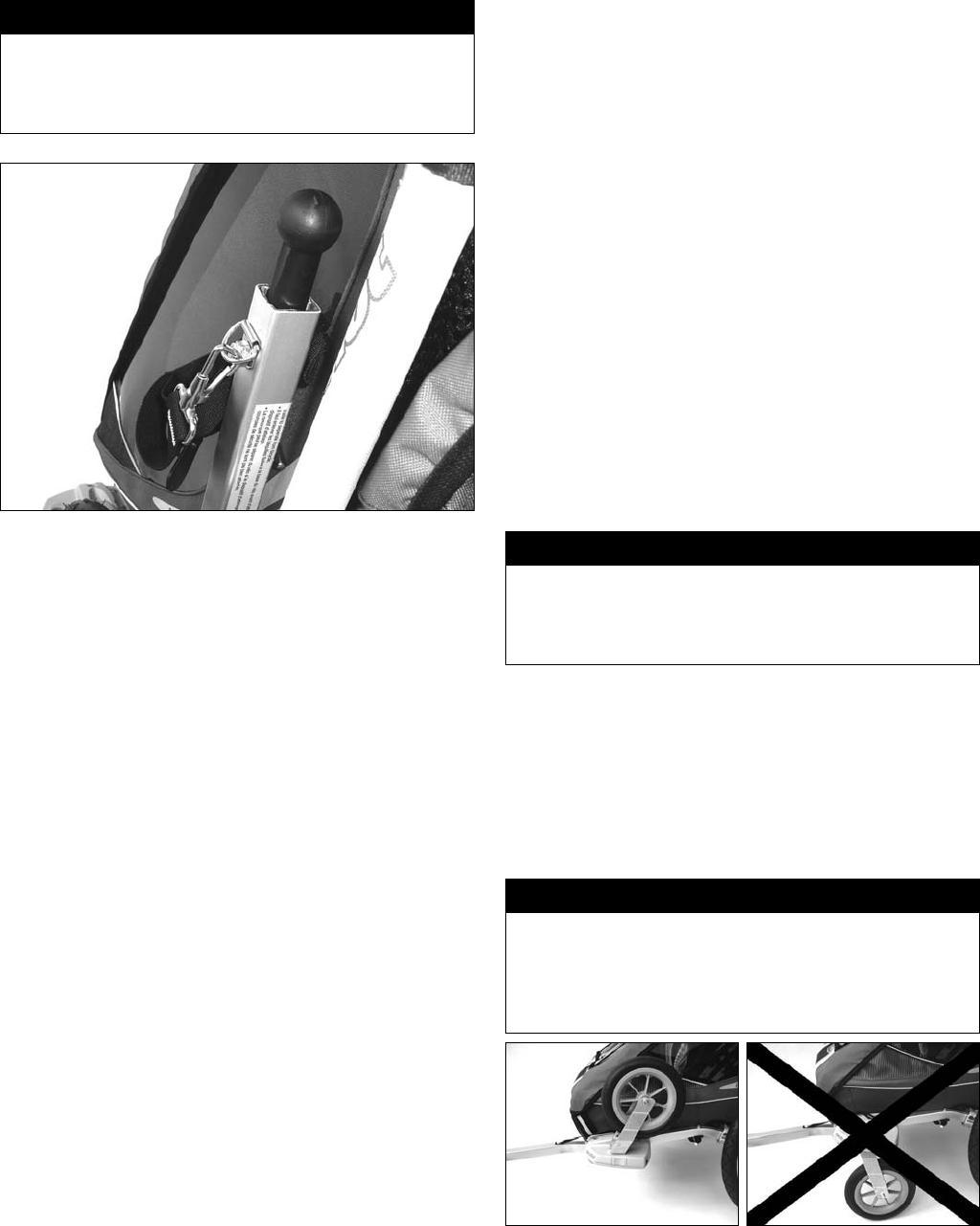
32
DANGER
Always attach the snap hook of the hitch back-up safety
strap to its accompanying D-ring on the hitcharm end that
now points upwards. If you do not do this, it could get caught
in the wheel spokes and cause an accident.
Use
Weight distribution and hitcharm load (tongue or nose
weight) on the hitch
The exact position of the seat in the Chariot has been specially
chosen so as to give optimum weight distribution if there are
only children sitting in the carrier.
The only other factor in weight distribution is the weight of
luggage items. The storage bags described in Section 3.7
are intended for the carrying of luggage items. The carrying
of luggage items next to the child on the seat is prohibited.
We would also urge against carrying luggage items in the foot
space.
Checking of the hitcharm load (tongue or nose weight) is
important if you want to carry a heavy load in the storage bags
along with a light child, or if you are using your Chariot as a
Bicycle Trailer.
The hitcharm load (tongue or nose weight) on the carrier hitch
needs to be 1 - 6 kg / 2.2 – 13.2 lb for safe road handling.
The hitcharm load (tongue or nose weight) is the weight that
you lift on the hitch when the carrier is loaded up.
If you are not confi dent about estimating the hitcharm load
(tongue or nose weight), use a bathroom scale to help you:
Put the bathroom scales next to the hitcharm of the loaded
carrier.
Stand on the scales and note your own weight.
Lift up the hitcharm at the hitch to around 30 cm/12 inches
above the ground.
The weight as displayed should now be 1 - 6 kg/2.2 – 13.2 lb
above your own weight.
1.
2.
3.
Suitability of the bicycle used for towing
Always make sure you follow the manufacturer’s specifi cations
in the owner’s manual of the bicycle used for towing, where the
suitability specifi cations of the bicycle are to be found.
Example 1: If the manufacturer states »This bicycle is suitable
for pulling an unbraked trailer of overall weight 40 kg«, then
you may add a maximum load of 30 kg, since the carrier itself
weighs approximately 10 kg/22 lb (e.g. Cheetah 1).
Example 2: If the manufacturer states »The permissible
bicycle full load of 120 kg/ 265 lb may not be exceeded. Please
note that the permissible full load may also not be exceeded if
you attach a trailer,« then, in order to determine the cargo load,
you need to subtract the weight of the bicycle, your own weight
and the carrier unloaded weight from the permissible full load.
For instance, if the bicycle weighs 15 kg/ 33 lb and the cyclist
weighs 72 kg/ 159 lb, then a maximum of 23 kg/ 51 lb additional
cargo load may be carried (120 - 15 - 72 - 10 = 23)/(265 – 33
– 159 – 22 = 51).
You will fi nd the weight specifi cations for your carrier in Section
13 “Specifi cations”.
DANGER
If there is nothing specifi ed in the owner’s manual of your bi-
cycle regarding towing a trailer, this does not mean that there
are no limitations. In such a case, always ask your specialist
retailer.
Correct assembly of the stroller
wheels for carrying them
out-of-use when used as a
Bicycle Trailer.
Wrong!!!
Travelling
Please ensure the following before each journey:
Follow all safety instructions at the beginning of this
section and the general safety instructions at the beginning
of the Owner’s Manual.
DANGER
When used as a Bicycle Trailer, the stroller wheels must
never be installed in their use position (wheels down). They
may only be carried in their out-of-use position (wheels up).
For a description of the positions of the stroller wheels, see
Section 7.


















